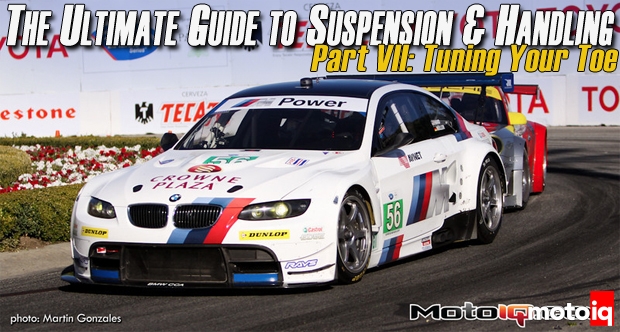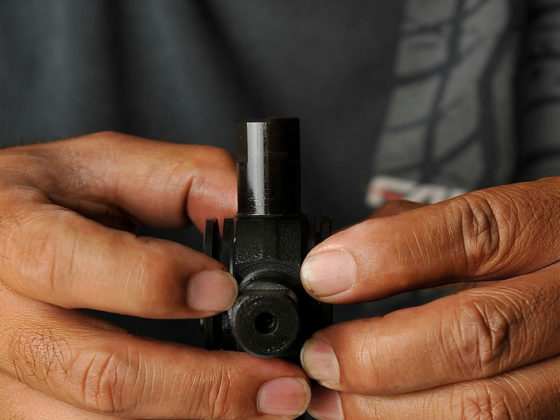,
Rear Toe In
Rear toe in is a useful setting that can make the car more stable under power application while turning. It can also be used to reduce trailing throttle oversteer or snap oversteer. Don’t overdo it, too much rear toe can cause initial understeer and snap oversteer.
 |
| High powered drift cars often run a lot of rear toe in which stabilizes the back of the car allowing the driver to really step on the gas and get more wheel spin. This is a crutch for proper suspension tuning but it is a quick and dirty suspension tuning trick that can be called upon in the fast paced environment of drifting. |
Rear Toe In |
| Just Right | Too Much |
| Helps a RWD car get on the throttle sooner and harder, making power oversteer feel more natural and manageable. | Makes a car sluggish in response and creates a tendency to understeer in mid turn and sometimes on exit. |
| Helps a driver of a drift car stand on the gas and sometimes get more forward bite under drift. | Gives a car a weird rocking wandering feeling on turn in. It feels very strange, unstable and awkward. |
| Less or zero toe can help an underpowered drift car maintain angle at high speed when the engine doesn’t have enough power to maintain wheel speed. | Makes a drift car twitchy under drift and want to grab traction and straighten out suddenly. Extreme toe in can cause initial understeer with a sudden transition to oversteer. |
| Can reduce or eliminate over rotation under trailing throttle or trail braking. |
 |
| An AE86 has a solid rear axle. If you want to adjust the toe setting you have to bend the axle housing. A good chassis shop can do this. |
 |
| B14 and B15 Nissan Sentras have beam rear axles. The axle has a lot of rear toe in from the factory which makes the handling twitchy at the limit. The rear beam axle must be bent to remove the toe in. |




9 comments
Practical tip: after using toe plates double check your work by placing a toe plate on the front and rear wheel on the same side of the car with the steering wheel pointed straight ahead. Lie on the ground and sight along the toe plates. Do the same on the opposite side of the car. This will show up any large errors in your toe plate alignment. It’s easy to turn a turnbuckle in the wrong direction and not notice if you skip this step. Also, be aware that changes in camber may or may not change toe. And ride height changes can affect camber and toe. So after lowering your car off the jackstands you need to bounce it at all four corners or drive it a short distance to make sure the suspension has settled back to its normal ride height. This last step is especially important if you have poly bushings which tend to have some initial resistance to rotation (hint: poly bushings occasionally need to be taken apart and greased). One last tip: On your street car if you see feathering on your tires (tread blocks wear into a wedge shape) you have a toe problem. On your track car if you have tire chunking (pieces of tread break off the tire carcass) you may have a toe problem.
when you refer to 1/8 or 1/4inch adjustments are you talking about just one side or the total amount of both left and right wheels?
Total
Hey Mike!
I was reading your The Ultimate Guide to Suspension and Handling for like three years without racing just dreaming of racing some day.
This year was my first year of ice racing. And damn! The difference correct toe tuning makes!
Just wanted to say how greatful I am for the guides.
Thanks mate!
Another thank you for Mike from me.
After reducing front toe-in to the minimum the equipment could register (0.03degrees each side) and reducing the rear toe-in (0.06 degrees each) and camber (from 2.6 to 2.0 degrees) and nothing else, cornering G went from 0.8 to 1.0 on winter tyres. 0.8 was ok, but 1.0 is excellent for a street setup and i can keep the car there as long as the turn lasts. Above 1.0G understeer sets in but I think a slight increase in track width, caster and SAI might raise that.
On good summer tyres the limit is higher but cant tell how high yet. With 215/50r17 Hankook Ventus prime2 on the rear and 225/45r17 Hankook ventus v12 evo2 up front the rear stepped out at 1.05G. Ordered wider wheels and 4 235/45r17 tyres, will see where we are after lockdown, but 1.15G or above i suspect.
Just wanted to share those numbers for people who are wondering how much differernce toe can make, though the reduced camber in the back will also have helped to make the car turn.
Hi from halfway across the world, Mike. I’m a big fan of your articles and this series in particular. What are your thoughts about using toe out to counter the toe in moment/effect caused by negative camber thrust? Assuming we don’t care about tire wear, of course.
Hope to hear from you soon. Cheers
Chez
Yes, that is one of the reasons why you do toe out.
Mike, thanks so much for all the great information, you’ve helped me drop seconds off my lap times.
I was wondering if the toe recommendations listed are total toe or per side?
Total toe in.